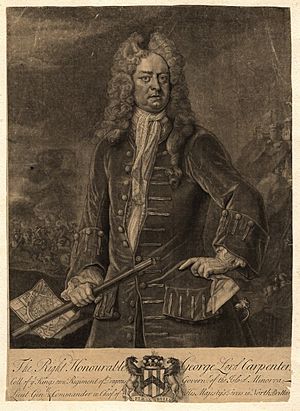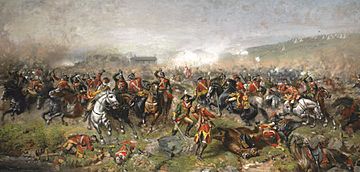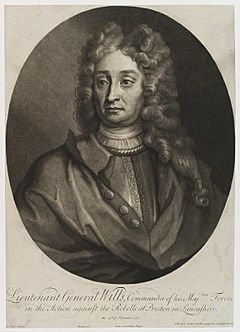George Carpenter, 1st Baron Carpenter facts for kids
Quick facts for kids
The Lord Carpenter
|
|
|---|---|

Lord Carpenter by John Faber the Younger, c. 1719
|
|
| Member of Parliament for Westminster |
|
| In office 1722–1727 |
|
| Governor of Menorca | |
| In office 1716–1718 |
|
| Commander-in-Chief, Scotland | |
| In office 1716–1724 |
|
| Member of Parliament for Whitchurch |
|
| In office 1715–1722 |
|
| Member of Parliament for Newtownards (Parliament of Ireland) |
|
| In office 1703–1705 |
|
| Personal details | |
| Born | 10 February 1657 Ocle Pychard, Herefordshire, England |
| Died | 10 February 1731 (aged 74) Longwood House, Hampshire, England, UK |
| Resting place | Owslebury |
| Political party | Whig |
| Spouse | Alice Margetson (1693–1731 †) |
| Children | George (1697–1749); Alicia (1705–1714?) |
| Occupation | Soldier and politician |
| Military service | |
| Allegiance | |
| Branch/service | Cavalry |
| Years of service | 1673–1722 |
| Rank | Lieutenant-General |
| Unit | Colonel, 3rd The King's Own Hussars 1703–1732 |
| Battles/wars | |
George Carpenter (born 10 February 1657 – died 10 February 1731) was an important British Army officer and politician. He was known as the 1st Baron Carpenter. He served as a Lieutenant-General in the army.
He was also a Whig politician. He was a member of parliament from 1715 to 1727. From 1716 to 1724, he was the Commander-in-Chief, Scotland.
Carpenter started his army career in 1685. He fought in the Williamite War in Ireland. Later, he moved to Flanders in 1692 for the Nine Years' War. He was a very skilled cavalry officer. He held high positions in the army during the War of the Spanish Succession. He was wounded several times and even captured once.
In 1715, he became a Member of Parliament (MP). He played a big role in stopping the Jacobite rising of 1715 in England. In 1719, he was given the title of Baron. He retired from politics in 1727.
Contents
Early Life and Family
George Carpenter was born on 10 February 1657. His birthplace was Ocle Pychard in Herefordshire, England. He was the youngest of seven children. His family had owned land in the area for over 400 years. Their main home was Homme, near Dilwyn.
In January 1694, Carpenter married Alice Margetson. She was a wealthy widow. They had two children together. Their son, George Carpenter, 2nd Baron Carpenter, was born in 1697. They also had a daughter named Alicia, born around 1705.
A Soldier's Journey: 1671 to 1714
Starting His Military Career
In 1671, George Carpenter became a page (a young servant) to Ralph Montagu. Montagu was an envoy for King Charles II of England. Carpenter returned home the next year. He then joined the Royal Horse Guards as a private soldier.
In 1685, King James II of England came to power. He was Catholic, which led to the Monmouth Rebellion. Carpenter was made a quartermaster in a cavalry troop. This troop helped to stop the rebellion. In 1687, his troop joined Peterborough's Regiment of Horse. Carpenter became a cornet, which is a junior officer rank.
Fighting in Ireland and Flanders

In 1688, King James was removed from power. William III became king in what was called the Glorious Revolution. Carpenter's unit fought in the Williamite War in Ireland from 1689 to 1691. They fought in the Battle of the Boyne in 1690. They also fought in the Battle of Aughrim in 1691. At Aughrim, Carpenter's unit bravely crossed a difficult bog under enemy fire.
The war in Ireland ended in October 1691. Carpenter's regiment then went to Flanders. They stayed there for the rest of the Nine Years' War. In January 1692, Carpenter was promoted to Lieutenant-Colonel. After the war ended in 1697, his regiment returned to Ireland.
Service in Spain
In 1703, Carpenter bought land in County Kilkenny, Ireland. He became a Member of Parliament (MP) for Newtownards in the Parliament of Ireland. He also bought the leadership of the 3rd The King's Own Hussars regiment. He kept this position until he died in 1732.
During the War of the Spanish Succession in 1704, Carpenter went to Spain. He was a Quartermaster and General of Cavalry. He supported the Habsburg candidate, Archduke Charles. In 1707, the British forces faced a big defeat at the Battle of Almansa. Carpenter was wounded, but his cavalry charges saved the army's cannons and supplies.
Later, James Stanhope took charge of the British forces in Spain. Carpenter helped win the battle of Almenara in 1710. However, a few months later, he was captured at the Battle of Brihuega. He was exchanged for another prisoner a few months later. He did not fight again before the war ended in 1714. At Brihuega, a musket ball hit him in the mouth. It knocked out his teeth and stayed in his throat for almost a year.
Later Career and Public Service
Stopping the Jacobite Rebellion

In 1714, George I became king. Carpenter was supposed to become an envoy (a diplomat) to Charles VI, Holy Roman Emperor. But before he could go, the Jacobite rising of 1715 began. This was a rebellion against the new king.
Carpenter was given command of the government forces in Northern England. He stopped the Jacobites from taking Newcastle. He forced them south to Preston. On 13 November, troops led by Charles Wills attacked the Jacobites. The next day, Carpenter joined Wills. The Jacobites had no way to escape and surrendered.
Carpenter and Wills had disagreed before. Carpenter felt Wills got too much credit for the victory at Preston. Their disagreement was settled by Marlborough. Carpenter was then made Commander-in-chief, Scotland. He held this job until 1724. He was also the Governor of Menorca from 1716 to 1718.
Becoming a Member of Parliament
In the 1715 election, Carpenter became an MP for Whitchurch. This area was controlled by the Whig party. His home, Longwood House, was nearby.
On 29 May 1719, he was given the title 'Baron Carpenter of Killaghy'. This was an Irish peerage. This meant he could still be an MP. In December 1722, he was elected MP for Westminster. Westminster was a very important area for Parliament. It had over 8,000 voters. Carpenter was chosen as the government's candidate. This showed how much they trusted him.
Carpenter retired from politics in 1727. He died on 10 February 1732. This was four months after his wife passed away. He was buried at St Andrew's church in Owslebury, Hampshire.
Images for kids
-
Charles Wills (left) and George Carpenter (right) worked together. They helped stop the Jacobite rebellion.



